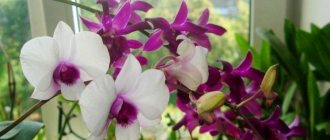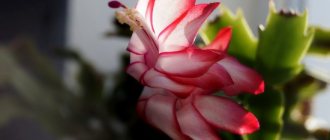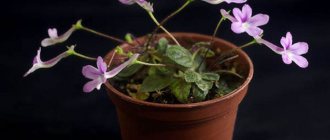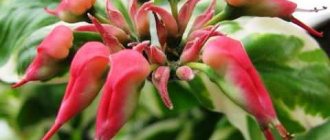The Gesneriaceae family includes about 3,200 species. Its prominent representative is Saintpaulia ( Usambara violet).
The culture is an extremely popular indoor plant. Flower growers first paid attention to wild Saintpaulias at the end of the 19th century. They were brought to Europe from East Africa. Then the German botanist Hermann Wenland described the plants and identified them as a separate genus. Immediately after this, the Uzambara violet was presented at an international flower show in the Belgian city of Ghent. From this moment on, active crop selection began.
All representatives of the Saintpaulia genus are herbaceous perennials. The plants are low-growing and compact: the height of the specimens does not exceed 20 cm, the diameter is 35-40 cm. The leathery, rounded leaves are pubescent with small villi. The base of the plates is heart-shaped, asymmetrical. Their color can be uniform (dark green) or spotted.
Saintpaulia is characterized by rapid growth. Life expectancy is 3-4 years, then decorative qualities are lost. Such specimens are rejuvenated by re-rooting the top. Uzambara violet blooms almost continuously.
| Growing quickly. |
| Blooms from late spring to early autumn. |
| The plant is easy to grow. |
| Up to 4 years, then should be rejuvenated. |
Useful properties of Saintpaulia
Preparations from the plant are added to cosmetics: they can relieve irritation, heal small cracks in the skin, and increase its elasticity. The leaves are used to treat acne. Essential oil is used by perfumers to create fragrances. Violet decoction helps with bronchitis, sore throat, and atherosclerosis.
Caring for Saintpaulia at home. Briefly
The culture has proven itself to be unpretentious. If you have basic skills, even a novice gardener can grow it. In order for Saintpaulia to feel comfortable at home, a number of parameters must be observed.
Basic requirements (memo):
| Temperature | In winter it should be at least 19˚C, in summer – about 22-25˚C. |
| Air humidity | 55-65%, however, you cannot irrigate the leaves with a spray bottle (to increase the indicator, the pots are placed on expanded clay, which is then sprayed with water). |
| Lighting | Moderate, placement on northern windows is acceptable. |
| Watering Saintpaulia | Depending on the season of the year (in summer, moisten the soil daily, in winter - once every 4 days). |
| Priming | Well-draining, specially designed for violets. |
| Feeding and fertilizer | Only in the warm season (once every 2 weeks). |
| Transfer | Annual (spring) with complete soil replacement. |
| Propagation of Saintpaulia | It is carried out by apical cuttings, air layering and parts of the stem so that several buds are present on it. |
| Peculiarities | Ease of propagation (by cuttings, “babies”, seeds), the possibility of obtaining new varieties with unusual petal colors through artificial pollination. |
The advantage of the Uzambara violet is that there is no need for pruning. The procedure is resorted to if weak leaf plates appear on the Saintpaulia, in case of mechanical damage, and also in order to obtain new plants.
Types and varieties of violets
The painstaking work of breeders has so enriched the violet world that it was necessary to create several classifications dividing varieties into groups.
In the American classification, violets are described and systematized according to the following characteristics:
- socket size;
- by leaf type;
- their colors;
- by type of flower;
- by the color of the petals;
- by the number of petals.
This classification, very complex due to the huge number of varieties, is used by many gardeners.
Classification by socket size
The sizes of Saintpaulia rosettes range from miniature to large with a half-meter diameter:
- micromini (up to 6 cm);
- mini (from 10 to 15 cm);
- midi (from 15 to 20 cm);
- standard (from 20 to 40cm);
- large standard (from 40 to 50 cm).
A separate category is trailer violet, which has elongated stems.
Violets with micro rosette
Leaf color and edge line
Saintpaulia usually produces an environment of serrated or entire velvety leaves that are round, oval or ovoid in shape with a heart-shaped base.
The upper side of the leaves can have a color from light to dark green, the lower side is pale green or purple, with sharply protruding veins, the leaves are pubescent along the edges, depending on the variety.
Caring for Saintpaulia at home. Details
Many gardeners make collecting specimens their hobby. New crop varieties are being developed almost constantly; there is even a fashion for some hybrids. What is necessary for a home-made Saintpaulia to continuously delight the owner with the appearance of new spectacular buds? Let's take a closer look at the plant's microclimate requirements.
Saintpaulia flowering
The intensity of the process is regulated by changing the level of illumination. With a large amount of sunlight, the Uzambara violet is able to constantly produce buds.
However, this is fraught with depletion of the plant. Therefore, it is recommended to move the pot to a shaded place once a year for 1.5-2 months to provide Saintpaulia rest. The variety of varieties does not allow us to give an unambiguous description of the appearance of the crop. There are both hybrids with simple flowers consisting of 5 petals, and specimens with double buds. They can be monochromatic or combine several shades.
Temperature
The Saintpaulia flower prefers warmth at home. In summer, the room temperature should be 22-25 ˚C, in winter – about 19 ˚C. The plant reacts poorly to excessive heat: during such periods it can completely stop flowering.
Uzambara violets cannot be taken out into the open air. In the warm season, it is allowed to move the pots to a glazed loggia or balcony. In this case, it is necessary to ensure that Saintpaulia is protected from drafts.
Spraying
The culture loves moist air. However, the pubescent leaf blades cannot tolerate water getting on them. Therefore, you cannot irrigate the plant with a spray bottle: this will lead to its rotting.
To maintain the parameter at a level of at least 55%, it is necessary to place containers with flowers in pallets filled with moistened sphagnum or small expanded clay. In this case, you cannot remove the saucers on which the pots are placed. You can purchase an industrial humidifier and turn it on periodically.
Lighting for Saintpaulia
Placement on southern windows is contraindicated for violets. In such conditions, leaf plates will bend outward and curl.
The plant develops best when located on the western or eastern side. The optimal length of daylight is 12 hours. Saintpaulia is shade-tolerant, so it can bloom safely even on a northern window. If few buds appear with such localization, an additional light source (phytolamp) should be installed.
If you have the appropriate equipment, you can grow Saintpaulia at home even in the depths of your apartment.
If the petioles of the leaves are elongated and the plates themselves take a vertical position, the lighting intensity should be increased.
Watering
For moisturizing, use soft water at room temperature that has settled for 3-4 days. Some plant growers prefer thawed or filtered. In summer the procedure is carried out every day, in winter – 2 times a week.
The substrate is watered when its surface is completely dry. This can be done in two ways: using a small watering can or by placing the pot in a container of water for 20-25 minutes. In the first case, you need to make sure that the drops do not fall on the leaves. It is important not to allow moisture to stagnate in the container with the flower.
Soil for Saintpaulia
To prepare the soil, you will need to mix:
- 1 part coarse sand;
- 3 parts peat;
- 5 parts leaf humus.
You can purchase ready-made substrate in the store.
Universal compositions for growing Saintpaulias are not suitable. It is necessary to choose special soils for violets.
Feeding and fertilizer
In its natural environment, the plant lives on depleted soils that contain few nutrients and microelements. Therefore, you cannot get carried away with fertilizing. During the winter, procedures are suspended, resuming them at the end of April. Fertilizing violets with mixtures with a high nitrogen content should be avoided.
For Saintpaulias, Kemira-Lux is suitable. When diluting the drug, add 2 times more liquid than required according to the instructions. Fertilizing is applied once every 2-2.5 weeks. You cannot use organic fertilizers such as “meat” water or tea leaves: this contributes to the appearance of leaf mosquitoes (sciarids) on the substrate.
Transplanting Saintpaulia
For a young plant, a container with a diameter of 6-7 cm is suitable, for an adult – about 12 cm. If you use a container that is too large, intensive development of the root system will begin, which will negatively affect flowering.
The procedure is carried out once a year, completely renewing the substrate. A medium-sized layer of expanded clay is placed on the bottom of the pot. The soil lump is carefully separated from the walls of the container, then the plant is removed. The roots are freed from the remaining soil, and rotten fragments are removed. If signs of disease are noticed on the specimen, you can immerse the roots for 5-7 minutes in a solution of potassium permanganate.
Trimming
Caring for Saintpaulia at home includes regular preventive inspections of the above-ground parts. Dried or mechanically damaged leaves are immediately cut off with a sharp, disinfected instrument.
Some gardeners remove “extra” plates to make the plant look symmetrical. In other cases, Saintpaulia does not need pruning.
Rest period
Uzambara violet is an evergreen perennial. It never sheds its leaves, so it does not have a pronounced dormant period. In Saintpaulia there are only short breaks between flowering phases. At such moments, you can provide the crop with shade and slightly reduce watering: thanks to this, more buds will subsequently form.
Spring care
Caring for violets in a pot at home is to ensure that they bloom. If the plant produces buds, it means it is healthy and has strong immunity. This is influenced by several factors:
- Proper watering. Violets should not be watered from above so that water gets into the internodes, leaves, and buds. This causes tissue rotting due to fungal infection.
- Lighting. Direct sunlight in summer is especially dangerous for violets. They cause leaf burns. A damaged plant will not bloom.
- Feeding. To grow buds, Saintpaulias consume a lot of nutrients, especially potassium and phosphorus, but ordinary fertilizers are not suitable for them - you need to buy a mixture for violets. In addition, it is necessary to maintain an acidic soil environment, since excess carbonates leads to withering of plants.
- Proper planting in a pot. You cannot replant violets into large pots, because they spend all their energy on growing the root system, so they forget to bloom at the right time.
Video: Violets for beginners
In the spring, when the plant wakes up, all the main activities are carried out with it. How to care for violets at home so that they bloom all summer long:
- At the beginning of March, it is necessary to feed those plants that are not planned to be replanted with a mixture for violets. It is carried out by watering at the root. Before fertilizing, moisten the soil, then drain the remaining liquid from the pan. The soil should be constantly moist, but without stagnant water.
- In the spring, the rosettes are thinned out - the lower leaves that formed first are removed. They won't grow anymore, so there's no point in wasting nutrients on them.
- In the spring, those violets that have grown since last year are replanted.
If plants are transplanted into new soil, fertilizing is not carried out.
Propagation of Saintpaulia
There are several ways to obtain new copies.
Propagation of Saintpaulia by leaf cuttings
Using leaf cuttings. To do this, the plate is cut with a sterile knife along with the petiole, leaving a length of 4-5 cm. The wound is sprinkled with crushed activated carbon. The powder is also added to water, into which plant fragments are then placed (1 tablet per glass of liquid). The first roots will appear in 2.5-3 weeks. After this, the cuttings are planted in small pots and covered with polyethylene for 1-2 weeks.
Growing Saintpaulia from seeds
Seeds. Select source plants that do not show signs of disease. Then artificial pollination is carried out with a soft brush. To do this, pollen from one specimen is transferred to the pistils of another. The pods will be fully ripe in about 4 months. To plant the extracted seeds, the top layer of soil is moistened. The material is mixed with sand and distributed on the soil without sprinkling. The dishes are covered with glass and placed in a warm place. Picking is carried out when the rosettes are sufficiently developed.
Reproduction by stepson
Stepsons. In order for them to appear, the growing point of the plant is removed. After some time, daughter shoots grow. When they reach 4-5 cm in diameter, they are separated and placed in individual containers.
Flower shape - bell
Violets, whose flowers resemble bells in shape, are not able to fully open due to the structural features of the peduncle: the fused bases of the petals. There are several specimens of this species worthy of home breeding.
Admiral
Flowers are cornflower blue with wavy edges. The variety is classified as semi-double. The leaves have decorative value: they have a white edge on a dark green background.
Sea wolf
Why they gave such a name to soft lilac terry violets is not clear. The variety has a large dark green bunch of leaves in a rosette. Blooms luxuriantly. The petals are wavy, arranged in 2 rows. With proper care they grow up to 8 cm in diameter.
Chanson
One of the easiest types of violets to care for. It blooms magnificently, producing several buds at once. The color is blue with pink spots. It is impossible to find two completely identical flowers.
Diseases and pests
Saintpaulias are not highly resistant to disease. However, with proper prevention, they can be protected from harm.
Insects and arachnids
The type of pest is determined by its characteristic symptoms (signs).
The most common:
- a white cotton-like coating on Saintpaulia cuttings appears when affected by mealybugs;
- quickly drying flowers and yellow pollen on the leaves are observed when attacked by Californian thrips;
- The upper leaves of Saintpaulia curl up, and the villi on the plates lengthen if cyclamen mites have settled on the plant.
Insecticides are used to eliminate parasites. In the latter case, biological or chemical acaricidal drugs can help.
Diseases
The cause of such conditions often lies in improper care. Most often, flower growers observe on violets:
- Saintpaulia does not bloom - due to excess nitrogen in the soil or lack of lighting;
- spots on the leaves of Saintpaulia - as a result of watering with cold water, exposure to drafts, direct sunlight;
- decrease in leaf turgor - when the substrate becomes waterlogged or dry;
- withering of unopened buds - due to decreased air humidity;
- grinding the central leaves of the rosette - in dry air or excess lighting;
- the edges of Saintpaulia leaves dry out - as a result of rare fertilizing;
- white coating on the above-ground parts of Saintpaulia - when affected by a fungus (“powdery mildew”);
- yellowing or redness of leaves - as a result of lack of nutrients;
- leaf rotting - due to the proliferation of late blight or gray rot pathogens.
Specimens must be inspected daily for signs of illness. If any are detected, treatment is started immediately to avoid the death of the plant.
If you need to go on vacation
It is not recommended to leave Saintpaulias for more than two days. If you expect a long absence, you need to ask someone to periodically water the substrate and monitor the humidity level in the room. Care should also include timely application of fertilizers.
If there is no assistant, and departure is inevitable, you can equip the pots with a wick watering system.
Types of Saintpaulia domestica
Due to the variety of varieties, the choice of violets in flower shops is very wide. Let's look at the most popular types today.
Blue Dragon
The hybrid has a powerful large socket. The leaves are monochromatic, rich green. The edges of the plates are jagged, their underside is reddish. The flowers are semi-double, bluish-purple petals have corrugated edges.
Midnight Frolik (Midnight Fun)
Variegated variety: green plates with white splashes along the edges. The loose rosette reaches a diameter of 40 cm. The leaf petioles are long. The hybrid blooms only at 2-3 years of age. The petals are purple-lilac in color.
Midnight Twist
Violet with ruffled semi-double flowers with a purple border. The foliage is monochromatic and green. The neat socket is compact and tight. The variety is distinguished by very lush and long-lasting flowering.
Kissing Bandit
The flowers of the hybrid are double or semi-double, lilac-blue. Opened buds reach a diameter of 6 cm. The foliage is shiny, dark green. The rosette is large and spreading.
Harry Potter
The foliage of the variety is green, “quilted”, the rosette is neat and compact. Purple petals are edged with a white border. The lifespan of each flower is about 2 months.
Cupidon (Cupid)
The flowers of the hybrid are double, the petals are white or pinkish, their edges are greenish-lemon. The leaf blades are plain with slightly wavy edges. The socket is large and neat. The variety is characterized by an early onset of flowering.
Breath Thunderstorms
The buds of the hybrid are very large, the petals closer to the core are burgundy, the edges are purple, the terry edging is white. Flowering is not abundant, but long lasting. The leaves are dark green, slightly wavy.
Having studied the care requirements of Uzambara violets, it is easy to avoid common mistakes. By creating the right microclimate and timely prevention of illnesses, this plant will delight you with beautiful flowers almost all year round.











